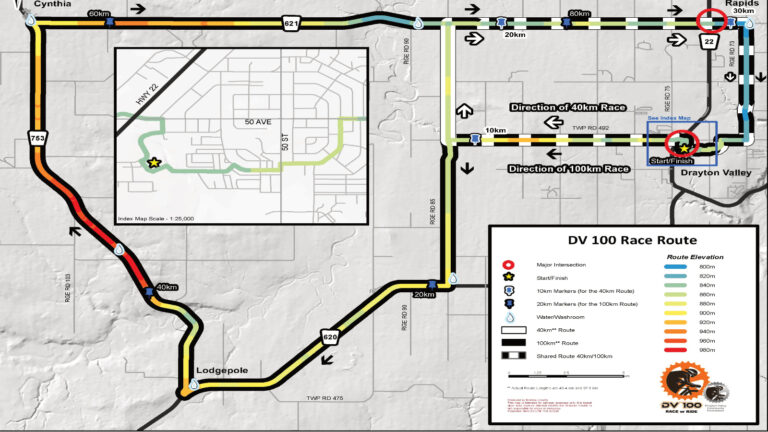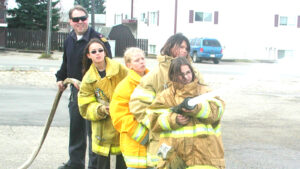Heading into the new year and beyond, the Town of Drayton Valley’s administration will be led by Robert Osmond.
Last week town council approved an employment agreement which will see Osmond take on the role of Chief Administrative Officer on a permanent basis.
“I’m looking forward to the next few years of working together,” said Mayor Nancy Dodds. “It makes it a little bit easier now that we know you’re going to be here for the long run.”
Osmond was initially appointed as interim CAO in mid-September. The town has been without a permanent CAO since Winston Rossouw stepped down in January.
Councillor Tom McGee also welcomed Osmond’s appointment.
“I do appreciate the value you bring to this table and to the community,” he said.
What Osmond brings includes 15 years of experience in municipal government. He has spent periods as assistant CAO in Lac St. Anne County and acting CAO in both Wetaskiwin and Redcliff.
As Chief Administrative Officer Osmond’s role is to oversee the day-to-day operations of the Town. As the administrative head of the municipality, the CAO ensures that municipal policies and programs are implemented and advises and informs council on the operation and affairs of the municipality.
Download your experience guide
Spending a weekend cycling the secondary highway in and around Brazeau County is one of the great outdoor activities that this region has to offer. Minutes outside of Drayton Valley you will find yourself on kilometers of highway that seem to continue to stretch West. Many of these highways go near small hamlets and communities in the area, they go into and come out of river valleys and on a clear day offer a beautiful view of the Rocky Mountains.
One such circuit is the DV100 century loop. This 100km route takes you west past farmlands and through lush boreal forests, and through the small communities and hamlets that mark the birth of Alberta’s oil and gas industry. It is a loop that can be done with speed or taken at a leisurely pace, offering snack and eatery stops along the way.

Day 1: Arrival, dinner
Arrive at hotel: When you stay at a Drayton Valley Hospitality and Tourism hotel or campground you support local tourism initiatives in Drayton Valley and Brazeau County.
Evening ride: Stretch your legs and do the 19 km ring road multipurpose trails to Rocky Rapids. Park your vehicle at the “Welcome to Drayton Valley” derricks at the south end of town and right across the street you will be on the trails. The route will take you straight out to the hamlet of Rocky Rapids where you can stop off at the Rocky Rapids store for a snack. The original building is located at the Drayton Valley museum.
Dinner: Did you know we have over 40 different restaurants in Drayton Valley? Look at our restaurant listing in this guide.
Ricochet Aquatic Centre: Take in the steamroom and the hot tub at the local swimming pool. The pool is open until 8:00 pm most nights and will get you ready for your big century ride tomorrow.
Day 2: The DIY DV100
Breakfast: Take in some breakfast at your hotel or head out to one of our great breakfast venues.
DIY DV100: The DV100 is a 100 kilometre route that travels secondary highways in Brazeau County. Along the route there are several spots you can stop to regroup, take in a photo and enjoy some food. Just out of town is the Poplar Ridge Store, this is your last stop to get any supplies until you reach the community of Lodgepole about about kilometre 40.
Arrive Lodgepole: this is a small hamlet that has a general store in the heart of town. Here you can grab a drink, and convenience store fare. There is also the hotel restaurant that is open 11-12:30 and 3-8 most days, there is also the Aud Spot for breakfast and lunch as a cash only option.
Heading out of Lodgepole towards Cynthia there are a few great photo opportunities as you crest a hill coming up from the Pembina River Valley. This is a slog of a climb but once you crest it is smooth sailing to Cynthia.
Near the Hamlet of Cynthia there is the ever popular Cyn City Saloon where you can get a beverage and a burger. Heading back towards Drayton Valley and Hwy 621 your next stop is 39 km away in the community of Rocky Rapids where you can stop at the store for some snacks and then back into town.
(In the Evening)
Hotel: regroup at your hotel and get ready for the evening.
Dinner: Drayton Valley has more than 40 different restaurants. Have a look at our listings page to decide where you want to eat.
Drinks: Head to a patio and enjoy the sunset with an ice cold brew. Lounge patios can be found at; Khal’s Steakhouse, Boston Pizza, Mitch’s Restaurant, Oil Country Tap House, Bourbon House and Mr. Mikes.

Day 3 Check out, walk and head home
Breakfast: Breakfast at your hotel or check out and head to a local restaurant for brunch.
Disc golf or a walk: If you want to stretch your time here in Drayton Valley, head over to Ivan To Park for a walk around the pond or a round of disc golf. The park has an 18-hole disc golf course that is open at no charge. If you’re pushed for time there’s an easy cut off to limit your round to 9 holes.
Head home. We hope you’ve enjoyed your time in our community. Come back soon!
Enforcement options limited
Staff Sergeant Ryan Hoetmer says dealing with the effects of the homeless population in the community is not simple.
Hoetmer says that the most common complaint regarding homeless individuals is about them sleeping or spending time in business entrances. That was one of the main issues raised by town council in a discussion on September 18.
Hoetmer says RCMP involvement in removing the individual and charging them with trespassing is a bit tricky, especially in regards to private businesses.
“The police themselves do not make a determination of whether that homeless individual can be there or not,” says Hoetmer. “That has to be the business that decides that.”
This means that someone from the business has to contact the RCMP to let them know there is an unwanted individual in the vestibule. At that point, police can attend and get the individual moving along.
However, unless the business has served trespass notices on the person causing the issue, the RCMP cannot issue fines for trespassing.
That is also not as simple as it seems. Hoetmer says that does give the trespass notice has to be willing to pursue the entire process into court as well.
“They’ve got to show up at trial if this individual fights it,” he says.
Hoetmer says banks, for example, are not typically interested in pursuing this as they all have nationally run security headquarters, so there’s not a lot of interest in them following those steps.
Both the Town and RCMP have met with bank managers and are encouraging them to lock their doors at night to prevent the homeless from using the vestibule as a warming space.
Due to the lifestyle that comes with homelessness, which often includes mental health issues and addictions, the RCMP do interact with the homeless on a regular basis.
“We get to know these individuals, but unless they are commiting crime we don’t have a lot of power,” he says.
He says the Town has asked them to have more enforcement on homeless individuals who have been banned or issued trespassing notices.
“Our job is community safety so if that’s what the community wants to keep the community safe, we’ve agreed to do that,” says Hoetmer.
However, that means businesses need to start following through with the process on their end.
In regards to the Civic Centre vestibule, Hoetmer says the Town would need to start looking at trespassing individuals in order for the RCMP to begin issuing tickets.
“That is up to the Town whether they want to trespass these individuals from all Town property,” says Hoetmer.
But even with all of the businesses doing their part and the RCMP able to keep up with the enforcement, there is still more to consider.
“Enforcement has failed these individuals for years. Nobody usually becomes unsheltered without probably having had enforcement intervention for a number of years already, and it hasn’t changed anything.”
Hoetmer says there have been no complaints of physical harm caused to residents by any homeless individuals. “They can be aggressive and make people feel uncomfortable, but we have had no assaults. No reports of any sort of physical violence to anybody.”
In regards to break and enters, Hoetmer says some of the smaller property crimes are being committed by homeless individuals, but they aren’t the only ones.
“There’s other individuals in town that are not homeless that are committing those offences,” says Hoetmer. “The bigger break and enters are being committed by prolific property crime offenders.”
In regards to issuing fines for trespassing, Hoetmer says that also isn’t as simple as many believe. Those who have fines may not be able to pay them. At some point, they can be arrested, but there is no guaranteed timeline for how long the individual will stay behind bars, as they will be released first if room is needed for people convicted of more serious crimes.
In the end, the fines do not get paid.
Hoetmer says he doesn’t want the Town to “hang their hat on enforcement,” because while it can play a role in deterring homeless individuals from becoming a nuisance, it’s not the entire solution.
“We’re going to have a role,” says Hoetmer. “Our job is keeping the community safe. So, if part of that is needing to enforce, then we will do that.”
Legacy of sixties scoop lives on
Drayton Valley high school students had the chance to listen to a first hand account of an indigenous woman whose life was drastically altered by the Sixties Scoop.
Michaela Lewis is now a student at SAIT, but her road there was long and arduous. She told the students that she is enrolled in the Film and Video Production program, which she plans to use to create a documentary about her life.
“It wasn’t just my family that I lost,” said Lewis. “It was my culture, my traditions, my language, my identity.”
Lewis’ mother, Bernice, gave birth to her in the spring of 1979 in the Edmonton General Hospital, and at the time was on her own. Bernice was married to a non-indigenous man, which meant that she and her children had lost their treaty rights. At the time of Lewis’ birth, the husband was in prison. Lewis was not his biological child.
Hospital staff told Bernice that she couldn’t raise a child on her own.
“The nurses and the hospital staff forced my mother into signing me away,” said Lewis.
She said her mother just went along with everything they told her to do because she felt like she had no other option. After she left the hospital, she went and got her other daughter before returning to the hospital to get Lewis.
When Bernice returned the next day, the staff told her that Lewis had been given to social services and that she had to deal with them. Lewis’ mother was given the run around by social services for several weeks before finally hearing that Lewis had died.
Instead, Lewis had been adopted out to a non-indigenous family. Social services also took her older sister from her mother.
“My older sister was lost to the system by the age of five,” says Lewis.
As a result of losing both of her children, Lewis’ mother turned to substances to cope and became an addict. For quite some time, her mother was homeless because there was no support system for her.
At 18 years-old, Lewis was able to unseal her adoption records and began to search for her family. Eventually, Lewis was reunited with her mother, stepfather, three sisters, brother, and a large extended family.
Lewis’ adopted mother had told her that “those native mothers, they left their unwanted babies in garbage cans and they were all alcoholics and addicts.” Lewis was even told she likely had fetal alcohol syndrome. It wasn’t until later that she found out that was not true. Bernice told Lewis that she hadn’t told anyone about Lewis because she thought that a nurse had ended Lewis’ life at the hospital after she had left her there.
Lewis was shocked as nurses were respected health care providers. She had been raised to believe there was a system in place that prevented such things. She began looking into the history and learned about the residential school system and all of the children who had been taken from their families.
Bernice told Lewis not to bother with trying to get justice because she would get nowhere. Her mother had been in the Bow Valley Residential School, and after learning of its history, Lewis understood why her mother had believed a nurse had killed Lewis.
Then, history repeated itself.
“My oldest son was taken from me when he was four-years-old,” said Lewis. “In that horrific moment, I completely understood why my mother lived the life that she did.”
At the time, Lewis was a single mother attending college to get her high school diploma. She had aspirations of becoming an interior designer.
When her son was five months old, his father left Lewis and later began stalking her. He threatened to take her son. Her adopted mother told her that if Lewis gave custody of her son to her adoptive mother, his father couldn’t take him and Lewis could still have the boy live with her.
“Desperate to keep my child, I agreed to it.”
Lewis was stressed out with everything going on, so her stepfather suggested she come back to live with them and finish her schooling with the support of her family. Lewis agreed and notified her adoptive mother of her move.
That was when her adoptive parents came and took her son.
“I didn’t even have a chance to have a say in court.”
Lewis became suicidal. She was unable to go back to school or get her job back and she spiraled, eventually becoming an addict.
“I’ve never in my life felt so broken, defeated, and alone,” she said.
It was her stepfather who helped her to heal and become sober. She says he was supportive and told her that she didn’t have to let the same thing happen to her that happened to her mother. After the conversation with her stepfather, Lewis began working to placate her adoptive parents so she could see her son.
Ten years after her son was taken, Lewis stood up to fight for her oldest son. When her second son was born in 2014, she told her adoptive parents that they wouldn’t keep her children apart. She regained custody of her son, and has been raising her youngest son since his birth.
Lewis said she is the first mother in several generations in her family, to have the opportunity to raise a child from birth.
Rural Watering Hole Tour
Download your experience guide
Before there were clubs, and ultra lounges there was the rural bar. The rural bar was a place people would go to have a drink, eat some food, get a bit of news and maybe even get a haircut. The rural bar was usually built alongside or attached to the lone hotel in the community. These were the first restaurants and live music venues and a place where the community could gather.
For our rural watering hole tour we dug up six watering holes in the Brazeau and Beyond region that hold historical significance for the communities they operate in.
Our tour begins at the Drayton Valley Hotel. The Drayton Valley Hotel was built in 1954. It was the anchor for what would become downtown Drayton Valley. Before the Derrick Lounge became a centerpiece of the Drayton Valley Hotel, there were many different shops that occupied the bottom floor of the building including Rexall Drugs, a menswear store, the Royal Bank of Canada and a cafe. The cafe was located on the storefront with the lounge located off the street in the back.
“I remember in 1999 you had to walk through the cafe to get to the lounge and it was draft for $1,” recalls resident Graham Long.
The Derrick Lounge, named in honour of the industry that gave rise to the development of Drayton Valley. This is a watering hole best known for its Friday night karaoke.
Iron Wheel Inn and Tavern, Entwistle
42 KM, 25 Minutes
Just 25 minutes drive, 42 kilometers north of Drayton Valley is the Iron Wheel Inn and Tavern. The Iron Wheel is located in the heart of Entwistle. The Iron Wheel dates back to 1910 when the building was originally the Immigration Hall built near the Grand Trunk Railroad Station. Parts of the Grand Trunk bridge footings can still be seen at the Pembina River Provincial Park. When the “Moose” Munroe’s hotel was destroyed in a fire in 1919, his eye turned to the immigration hall which was no longer in use. Through a series of exchanges Munroe acquired the hall and began operating it as a hotel. In 1922 the hall was moved, in two parts, to the current location of the Iron Wheel Inn and Tavern where it remains to this day.
Gainford Hotel, Iron Lady Saloon, Gainford
15 KM, 9 minutes
Gainford is a tiny hamlet of 118 people in Parkland County. It is 86 km west of Edmonton on Highway 16 (Yellowhead Highway) and 18 km from Entwistle. The Gainford Hotel first opened its doors to welcome guests in 1958. In those days hotel guests were seismic and construction crews working in the area. As things changed the hotel became a stomping ground for university students heading out to Seba Beach for a hot summer weekend. The hotel closed in 2013 only to be revived a decade later. In 2023 the Iron Lady Saloon and Java and Gem Get Stuffed Restaurant opened their doors. The inside has a distinct western feel. There’s a traditional dark wood bar and billiards. Stuffed coyotes, lynx, rabbits, owls, and hawks still decorate the tavern walls from days gone by.
The Iron Lady Saloon is known for various Saturday night live music events.
Doggone Saloon, Tomahawk
25 KM, 17 minutes
Just a 17 minute drive from Gainford is the hamlet of Tomahawk. If you are looking for a rural watering hole experience this is as rural as it comes. The history of Tomahawk dates back to 1902. With the first mention of a hotel and cafe dating back 1909. The “Last Chance Cafe” was owned by John Kelly; it was described as a “shack right in the road,” by Mrs. Kelly in Tomahawk Trails. The cafe became known as the Last Chance Hotel. “Meals at all hours, people stayed there when they could stay at no place else. The door was open day or night whether he [Kelly] was home or not and people stayed as long as they wanted to,” Mrs. Kelly wrote. The hospitality in the area now belongs to the Doggone Saloon, in the middle of Tomahawk. The saloon is still a favorite stop for travelers passing by. Throughout the summer months motorcyclists riding Alberta’s scenic rural roads will stop off at the saloon for the patio and a refreshment.
The Village Golf Course, Lindale
21km 15 min
Honorable Mention: The lounge at the Village Golf Course is another stop you can add to your rural bar tour. The lounge is connected to the hotel and club house for the Village Golf Course. The lounge offers beverages and a food full menu.
The Breton Hotel and Bar, Breton
32 KM, 22 minutes
The Breton Hotel and Bar was built five years after the Lacome and Northwestern Railway came to the community. The hotel was built by William Spindler in 1931. In those days, like many other rural hotels and bars the Breton Hotel and Bar also had a barber shop. The decades that followed the 1930s, the bar had two entrances: one each for men and women. Over the years the hotel and bar was bought and sold many times with each new owner adding to or changing the design of the building. Joe and Katie Eluik purchased the hotel in 1964, at this time draft beer sold for 10 cents a glass, bottled beer was 30 cents and a case of beer could be bought for $2.50. The prices are not the only changes that happened, the separate entrances are no longer used, and the peaked roof in the original design has been redesigned as a flat top.
The Breton Hotel and Bar is still a fixture in downtown Breton.
Drayton’s Restaurant and Sports Lounge, Drayton Valley
48 KM, 34 minutes
Honorable Mention: As you meander back to Drayton Valley the Sports Lounge, attached to Drayton’s Restaurant is a worthy stop of this rural watering hole tour. The sports lounge has a distinct small town feel with billiards, friendly staff and a diverse menu. This is a place where you can unwind in the heart of Drayton Valley.
From the Sports Lounge you are just a block away from where you started at the Drayton Valley Hotel.
The old hotels, and bars that pepper our rural communities are linked to how the communities developed, and socialized in the down time between farming seasons, or at the end of a hard work day. They have a unique history that has evolved with the community and share in the community’s past and future.
Drayton really does have talent
Drayton Valley’s River Valley Players provided two well produced showcases for our local talent last weekend. Drayton Valley Has Talent 2024 junior and adult showcases were held the afternoon and evening of September 21 on the Pembina Stage of Eleanor Pickup Arts Centre in downtown Drayton Valley. The performances all benefited from full light and sound and the volunteer stage hands’ efficient handling of set changes.
Master of Ceremonies Leah Sanderson kept the evening on track and filled the space between acts with pleasant patter and some observational humour. Several rounds of “Happy Birthday to You” honoured those celebrating their special day.
With the last performer off stage, judge’s score sheets tabulated and result envelopes in the MC’s hand, audience drumrolls raised tension in the theatre as the winners were announced. The Junior results put Ella Rae’s performance of the Haley Joelle song, “Memory Lane” in third, Dandaline and Delilah Dusterhoft’s dance to “Daylight” in second, and the ventriloquism of Taylor Holman and her humourous puppets Rose, Grandma, a dog and a wise cracking, bacon loving goose first place. An audience favourite, Ms Holman’s performance sparkled with wit and laughs as her polished style and technique belied her years.
The adult category results placed Elvis performer Dustin Giesbrecht’s tribute to “Burning Love”, in third, and a performance of Keith Urban’s “Till Summer Comes Around” by Levi Eshleman in second. First place was awarded to an accomplished performance of the Liz Callaway song “Once Upon a December” from the Disney movie Anastasia. Claire Williams sung it with a sureness, intonation and presence that earned her the top spot.
Ayla Gartner, Ricky Bazar, John Dempster, and Melissa Wolf judged the performances. They were supportive and encouraging of the performers’ efforts and offered positive comments and suggested areas for growth.
Ashley Luckwell of RVP was grateful to the many local sponsors that made Drayton Valley Has Talent 2024 possible. “Being able to have two shows and have close to a full house in each meant we didn’t have to turn anyone away, audience or performers. It was wonderful!”
She was pleased with the generous spirit of the two audiences the showcase attracted and the great support they too gave to the junior and adult performers. “The audience’s support for the performers was amazing, very moving”, Luckwell commented. The audience came to the aid in a few performer’s faltering moments with cheers, applause and encouraging words.
Wildrose Schools starts cell phone ban this September
Students may have a different learning experience this year after the Alberta Education Minister, Demetrios Nicolaides, made the call to ban cell phones in schools.
Brad Volkman, the superintendent of the Wild Rose School Division, says schools have until 2025 to create a policy regarding cell phone use, but they have to start implementing the ban in September.
Volkman says that for many schools, a ban on cell phones is business as usual.
“Quite frankly, many of our schools have already been doing that for years,” says Volkman.
However, cell phone policies have been left to individual schools to plan and implement. Now, the division itself needs to have something in place.
Volkman says division staff met with school staff to review the policy before the school year. He says the major points were that cell phones could not be used during learning time with the exception of those who have learning or medical needs that require the phones.
Right now, WRSD is using the time given to create their policy to test out different ways of implementing it and enforcing the rules. Each school is putting their own policies in place for the first month. After getting feedback from school staff, parents, and students, the division will be able to put together something that is effective and practical.
He says each school has a different approach to dealing with the phones. One approach requires students to leave their phones at the front of the classroom during instruction time. In some schools, students are required to leave their phones in their backpacks, or in others, teachers will confiscate phones if they catch their students using them.
“What we realized, and there is some research on this, is that we’ve got students that are probably addicted to their phone,” says Volkman. “The minute [the phones] buzz they have to look.”
Another important part of the ban on cell phones is also a ban on social media in the schools. The Minister’s directive doesn’t establish whether all social media needs to be blocked, or if it only applies to certain sites.
“Believe it or not, it’s up to the school division to decide which sites need to be blocked. They didn’t give us a list,” says Volkman.
Another area of the Minister’s order that isn’t very clear has to do with blocking the social media school-wide. The division is able to block the sites through their wifi, but they can’t block the sites for students who have data plans on their phones.
“The Minister’s Order doesn’t address that,” says Volkman. “The Minister’s Order says they can’t use their mobile devices during instructional time and it says that the networks that they connect to must block social media. But it doesn’t address anything around kids using their own data plans during breaks to access social media.”
Volkman says the division has been doing its best to implement the order while figuring out how to handle the effects that some of those implementations have had.
Right now, students are blocked from accessing social media via the school’s network. However, the staff are also blocked. This means that staff cannot use social media to update parents or advertise for upcoming events. As it stands, the division is unable to specify who may have access to social media and which social media needs to be blocked.
He says the division is working to find a way that will allow staff to communicate with parents and students while adhering to the Minister’s ban.
Volkman says the division’s policy will outline a progressive disciplinary plan for any infractions with cell phone use. He says it’s the same way they ask all of their schools to deal with transgressions.
“This will be no different than any other school policy or school rule,” he says. “You start easy, with understanding, grace, and education… but you do have to have a progressive style approach.”
Volkman says the goal is to have a draft put together by mid-October for stakeholders to review in November. In December, they will be putting the final touches on the policy so it is ready to be rolled out in the new year.
Lorem ipsum dolor sit amet, consectetur adipiscing elit. Ut elit tellus, luctus nec ullamcorper mattis, pulvinar dapibus leo.
Osmond thanked council for the opportunity and said he was looking forward to getting to work on a permanent basis.
“I’m certainly very excited about the things we’re going to do together,” he said.
Download your experience guide
Spending a weekend cycling the secondary highway in and around Brazeau County is one of the great outdoor activities that this region has to offer. Minutes outside of Drayton Valley you will find yourself on kilometers of highway that seem to continue to stretch West. Many of these highways go near small hamlets and communities in the area, they go into and come out of river valleys and on a clear day offer a beautiful view of the Rocky Mountains.
One such circuit is the DV100 century loop. This 100km route takes you west past farmlands and through lush boreal forests, and through the small communities and hamlets that mark the birth of Alberta’s oil and gas industry. It is a loop that can be done with speed or taken at a leisurely pace, offering snack and eatery stops along the way.

Day 1: Arrival, dinner
Arrive at hotel: When you stay at a Drayton Valley Hospitality and Tourism hotel or campground you support local tourism initiatives in Drayton Valley and Brazeau County.
Evening ride: Stretch your legs and do the 19 km ring road multipurpose trails to Rocky Rapids. Park your vehicle at the “Welcome to Drayton Valley” derricks at the south end of town and right across the street you will be on the trails. The route will take you straight out to the hamlet of Rocky Rapids where you can stop off at the Rocky Rapids store for a snack. The original building is located at the Drayton Valley museum.
Dinner: Did you know we have over 40 different restaurants in Drayton Valley? Look at our restaurant listing in this guide.
Ricochet Aquatic Centre: Take in the steamroom and the hot tub at the local swimming pool. The pool is open until 8:00 pm most nights and will get you ready for your big century ride tomorrow.
Day 2: The DIY DV100
Breakfast: Take in some breakfast at your hotel or head out to one of our great breakfast venues.
DIY DV100: The DV100 is a 100 kilometre route that travels secondary highways in Brazeau County. Along the route there are several spots you can stop to regroup, take in a photo and enjoy some food. Just out of town is the Poplar Ridge Store, this is your last stop to get any supplies until you reach the community of Lodgepole about about kilometre 40.
Arrive Lodgepole: this is a small hamlet that has a general store in the heart of town. Here you can grab a drink, and convenience store fare. There is also the hotel restaurant that is open 11-12:30 and 3-8 most days, there is also the Aud Spot for breakfast and lunch as a cash only option.
Heading out of Lodgepole towards Cynthia there are a few great photo opportunities as you crest a hill coming up from the Pembina River Valley. This is a slog of a climb but once you crest it is smooth sailing to Cynthia.
Near the Hamlet of Cynthia there is the ever popular Cyn City Saloon where you can get a beverage and a burger. Heading back towards Drayton Valley and Hwy 621 your next stop is 39 km away in the community of Rocky Rapids where you can stop at the store for some snacks and then back into town.
(In the Evening)
Hotel: regroup at your hotel and get ready for the evening.
Dinner: Drayton Valley has more than 40 different restaurants. Have a look at our listings page to decide where you want to eat.
Drinks: Head to a patio and enjoy the sunset with an ice cold brew. Lounge patios can be found at; Khal’s Steakhouse, Boston Pizza, Mitch’s Restaurant, Oil Country Tap House, Bourbon House and Mr. Mikes.

Day 3 Check out, walk and head home
Breakfast: Breakfast at your hotel or check out and head to a local restaurant for brunch.
Disc golf or a walk: If you want to stretch your time here in Drayton Valley, head over to Ivan To Park for a walk around the pond or a round of disc golf. The park has an 18-hole disc golf course that is open at no charge. If you’re pushed for time there’s an easy cut off to limit your round to 9 holes.
Head home. We hope you’ve enjoyed your time in our community. Come back soon!
Staff Sergeant Ryan Hoetmer says dealing with the effects of the homeless population in the community is not simple.
Hoetmer says that the most common complaint regarding homeless individuals is about them sleeping or spending time in business entrances. That was one of the main issues raised by town council in a discussion on September 18.
Hoetmer says RCMP involvement in removing the individual and charging them with trespassing is a bit tricky, especially in regards to private businesses.
“The police themselves do not make a determination of whether that homeless individual can be there or not,” says Hoetmer. “That has to be the business that decides that.”
This means that someone from the business has to contact the RCMP to let them know there is an unwanted individual in the vestibule. At that point, police can attend and get the individual moving along.
However, unless the business has served trespass notices on the person causing the issue, the RCMP cannot issue fines for trespassing.
That is also not as simple as it seems. Hoetmer says that does give the trespass notice has to be willing to pursue the entire process into court as well.
“They’ve got to show up at trial if this individual fights it,” he says.
Hoetmer says banks, for example, are not typically interested in pursuing this as they all have nationally run security headquarters, so there’s not a lot of interest in them following those steps.
Both the Town and RCMP have met with bank managers and are encouraging them to lock their doors at night to prevent the homeless from using the vestibule as a warming space.
Due to the lifestyle that comes with homelessness, which often includes mental health issues and addictions, the RCMP do interact with the homeless on a regular basis.
“We get to know these individuals, but unless they are commiting crime we don’t have a lot of power,” he says.
He says the Town has asked them to have more enforcement on homeless individuals who have been banned or issued trespassing notices.
“Our job is community safety so if that’s what the community wants to keep the community safe, we’ve agreed to do that,” says Hoetmer.
However, that means businesses need to start following through with the process on their end.
In regards to the Civic Centre vestibule, Hoetmer says the Town would need to start looking at trespassing individuals in order for the RCMP to begin issuing tickets.
“That is up to the Town whether they want to trespass these individuals from all Town property,” says Hoetmer.
But even with all of the businesses doing their part and the RCMP able to keep up with the enforcement, there is still more to consider.
“Enforcement has failed these individuals for years. Nobody usually becomes unsheltered without probably having had enforcement intervention for a number of years already, and it hasn’t changed anything.”
Hoetmer says there have been no complaints of physical harm caused to residents by any homeless individuals. “They can be aggressive and make people feel uncomfortable, but we have had no assaults. No reports of any sort of physical violence to anybody.”
In regards to break and enters, Hoetmer says some of the smaller property crimes are being committed by homeless individuals, but they aren’t the only ones.
“There’s other individuals in town that are not homeless that are committing those offences,” says Hoetmer. “The bigger break and enters are being committed by prolific property crime offenders.”
In regards to issuing fines for trespassing, Hoetmer says that also isn’t as simple as many believe. Those who have fines may not be able to pay them. At some point, they can be arrested, but there is no guaranteed timeline for how long the individual will stay behind bars, as they will be released first if room is needed for people convicted of more serious crimes.
In the end, the fines do not get paid.
Hoetmer says he doesn’t want the Town to “hang their hat on enforcement,” because while it can play a role in deterring homeless individuals from becoming a nuisance, it’s not the entire solution.
“We’re going to have a role,” says Hoetmer. “Our job is keeping the community safe. So, if part of that is needing to enforce, then we will do that.”
Drayton Valley high school students had the chance to listen to a first hand account of an indigenous woman whose life was drastically altered by the Sixties Scoop.
Michaela Lewis is now a student at SAIT, but her road there was long and arduous. She told the students that she is enrolled in the Film and Video Production program, which she plans to use to create a documentary about her life.
“It wasn’t just my family that I lost,” said Lewis. “It was my culture, my traditions, my language, my identity.”
Lewis’ mother, Bernice, gave birth to her in the spring of 1979 in the Edmonton General Hospital, and at the time was on her own. Bernice was married to a non-indigenous man, which meant that she and her children had lost their treaty rights. At the time of Lewis’ birth, the husband was in prison. Lewis was not his biological child.
Hospital staff told Bernice that she couldn’t raise a child on her own.
“The nurses and the hospital staff forced my mother into signing me away,” said Lewis.
She said her mother just went along with everything they told her to do because she felt like she had no other option. After she left the hospital, she went and got her other daughter before returning to the hospital to get Lewis.
When Bernice returned the next day, the staff told her that Lewis had been given to social services and that she had to deal with them. Lewis’ mother was given the run around by social services for several weeks before finally hearing that Lewis had died.
Instead, Lewis had been adopted out to a non-indigenous family. Social services also took her older sister from her mother.
“My older sister was lost to the system by the age of five,” says Lewis.
As a result of losing both of her children, Lewis’ mother turned to substances to cope and became an addict. For quite some time, her mother was homeless because there was no support system for her.
At 18 years-old, Lewis was able to unseal her adoption records and began to search for her family. Eventually, Lewis was reunited with her mother, stepfather, three sisters, brother, and a large extended family.
Lewis’ adopted mother had told her that “those native mothers, they left their unwanted babies in garbage cans and they were all alcoholics and addicts.” Lewis was even told she likely had fetal alcohol syndrome. It wasn’t until later that she found out that was not true. Bernice told Lewis that she hadn’t told anyone about Lewis because she thought that a nurse had ended Lewis’ life at the hospital after she had left her there.
Lewis was shocked as nurses were respected health care providers. She had been raised to believe there was a system in place that prevented such things. She began looking into the history and learned about the residential school system and all of the children who had been taken from their families.
Bernice told Lewis not to bother with trying to get justice because she would get nowhere. Her mother had been in the Bow Valley Residential School, and after learning of its history, Lewis understood why her mother had believed a nurse had killed Lewis.
Then, history repeated itself.
“My oldest son was taken from me when he was four-years-old,” said Lewis. “In that horrific moment, I completely understood why my mother lived the life that she did.”
At the time, Lewis was a single mother attending college to get her high school diploma. She had aspirations of becoming an interior designer.
When her son was five months old, his father left Lewis and later began stalking her. He threatened to take her son. Her adopted mother told her that if Lewis gave custody of her son to her adoptive mother, his father couldn’t take him and Lewis could still have the boy live with her.
“Desperate to keep my child, I agreed to it.”
Lewis was stressed out with everything going on, so her stepfather suggested she come back to live with them and finish her schooling with the support of her family. Lewis agreed and notified her adoptive mother of her move.
That was when her adoptive parents came and took her son.
“I didn’t even have a chance to have a say in court.”
Lewis became suicidal. She was unable to go back to school or get her job back and she spiraled, eventually becoming an addict.
“I’ve never in my life felt so broken, defeated, and alone,” she said.
It was her stepfather who helped her to heal and become sober. She says he was supportive and told her that she didn’t have to let the same thing happen to her that happened to her mother. After the conversation with her stepfather, Lewis began working to placate her adoptive parents so she could see her son.
Ten years after her son was taken, Lewis stood up to fight for her oldest son. When her second son was born in 2014, she told her adoptive parents that they wouldn’t keep her children apart. She regained custody of her son, and has been raising her youngest son since his birth.
Lewis said she is the first mother in several generations in her family, to have the opportunity to raise a child from birth.
Download your experience guide
Before there were clubs, and ultra lounges there was the rural bar. The rural bar was a place people would go to have a drink, eat some food, get a bit of news and maybe even get a haircut. The rural bar was usually built alongside or attached to the lone hotel in the community. These were the first restaurants and live music venues and a place where the community could gather.
For our rural watering hole tour we dug up six watering holes in the Brazeau and Beyond region that hold historical significance for the communities they operate in.
Our tour begins at the Drayton Valley Hotel. The Drayton Valley Hotel was built in 1954. It was the anchor for what would become downtown Drayton Valley. Before the Derrick Lounge became a centerpiece of the Drayton Valley Hotel, there were many different shops that occupied the bottom floor of the building including Rexall Drugs, a menswear store, the Royal Bank of Canada and a cafe. The cafe was located on the storefront with the lounge located off the street in the back.
“I remember in 1999 you had to walk through the cafe to get to the lounge and it was draft for $1,” recalls resident Graham Long.
The Derrick Lounge, named in honour of the industry that gave rise to the development of Drayton Valley. This is a watering hole best known for its Friday night karaoke.
Iron Wheel Inn and Tavern, Entwistle
42 KM, 25 Minutes
Just 25 minutes drive, 42 kilometers north of Drayton Valley is the Iron Wheel Inn and Tavern. The Iron Wheel is located in the heart of Entwistle. The Iron Wheel dates back to 1910 when the building was originally the Immigration Hall built near the Grand Trunk Railroad Station. Parts of the Grand Trunk bridge footings can still be seen at the Pembina River Provincial Park. When the “Moose” Munroe’s hotel was destroyed in a fire in 1919, his eye turned to the immigration hall which was no longer in use. Through a series of exchanges Munroe acquired the hall and began operating it as a hotel. In 1922 the hall was moved, in two parts, to the current location of the Iron Wheel Inn and Tavern where it remains to this day.
Gainford Hotel, Iron Lady Saloon, Gainford
15 KM, 9 minutes
Gainford is a tiny hamlet of 118 people in Parkland County. It is 86 km west of Edmonton on Highway 16 (Yellowhead Highway) and 18 km from Entwistle. The Gainford Hotel first opened its doors to welcome guests in 1958. In those days hotel guests were seismic and construction crews working in the area. As things changed the hotel became a stomping ground for university students heading out to Seba Beach for a hot summer weekend. The hotel closed in 2013 only to be revived a decade later. In 2023 the Iron Lady Saloon and Java and Gem Get Stuffed Restaurant opened their doors. The inside has a distinct western feel. There’s a traditional dark wood bar and billiards. Stuffed coyotes, lynx, rabbits, owls, and hawks still decorate the tavern walls from days gone by.
The Iron Lady Saloon is known for various Saturday night live music events.
Doggone Saloon, Tomahawk
25 KM, 17 minutes
Just a 17 minute drive from Gainford is the hamlet of Tomahawk. If you are looking for a rural watering hole experience this is as rural as it comes. The history of Tomahawk dates back to 1902. With the first mention of a hotel and cafe dating back 1909. The “Last Chance Cafe” was owned by John Kelly; it was described as a “shack right in the road,” by Mrs. Kelly in Tomahawk Trails. The cafe became known as the Last Chance Hotel. “Meals at all hours, people stayed there when they could stay at no place else. The door was open day or night whether he [Kelly] was home or not and people stayed as long as they wanted to,” Mrs. Kelly wrote. The hospitality in the area now belongs to the Doggone Saloon, in the middle of Tomahawk. The saloon is still a favorite stop for travelers passing by. Throughout the summer months motorcyclists riding Alberta’s scenic rural roads will stop off at the saloon for the patio and a refreshment.
The Village Golf Course, Lindale
21km 15 min
Honorable Mention: The lounge at the Village Golf Course is another stop you can add to your rural bar tour. The lounge is connected to the hotel and club house for the Village Golf Course. The lounge offers beverages and a food full menu.
The Breton Hotel and Bar, Breton
32 KM, 22 minutes
The Breton Hotel and Bar was built five years after the Lacome and Northwestern Railway came to the community. The hotel was built by William Spindler in 1931. In those days, like many other rural hotels and bars the Breton Hotel and Bar also had a barber shop. The decades that followed the 1930s, the bar had two entrances: one each for men and women. Over the years the hotel and bar was bought and sold many times with each new owner adding to or changing the design of the building. Joe and Katie Eluik purchased the hotel in 1964, at this time draft beer sold for 10 cents a glass, bottled beer was 30 cents and a case of beer could be bought for $2.50. The prices are not the only changes that happened, the separate entrances are no longer used, and the peaked roof in the original design has been redesigned as a flat top.
The Breton Hotel and Bar is still a fixture in downtown Breton.
Drayton’s Restaurant and Sports Lounge, Drayton Valley
48 KM, 34 minutes
Honorable Mention: As you meander back to Drayton Valley the Sports Lounge, attached to Drayton’s Restaurant is a worthy stop of this rural watering hole tour. The sports lounge has a distinct small town feel with billiards, friendly staff and a diverse menu. This is a place where you can unwind in the heart of Drayton Valley.
From the Sports Lounge you are just a block away from where you started at the Drayton Valley Hotel.
The old hotels, and bars that pepper our rural communities are linked to how the communities developed, and socialized in the down time between farming seasons, or at the end of a hard work day. They have a unique history that has evolved with the community and share in the community’s past and future.
Drayton Valley’s River Valley Players provided two well produced showcases for our local talent last weekend. Drayton Valley Has Talent 2024 junior and adult showcases were held the afternoon and evening of September 21 on the Pembina Stage of Eleanor Pickup Arts Centre in downtown Drayton Valley. The performances all benefited from full light and sound and the volunteer stage hands’ efficient handling of set changes.
Master of Ceremonies Leah Sanderson kept the evening on track and filled the space between acts with pleasant patter and some observational humour. Several rounds of “Happy Birthday to You” honoured those celebrating their special day.
With the last performer off stage, judge’s score sheets tabulated and result envelopes in the MC’s hand, audience drumrolls raised tension in the theatre as the winners were announced. The Junior results put Ella Rae’s performance of the Haley Joelle song, “Memory Lane” in third, Dandaline and Delilah Dusterhoft’s dance to “Daylight” in second, and the ventriloquism of Taylor Holman and her humourous puppets Rose, Grandma, a dog and a wise cracking, bacon loving goose first place. An audience favourite, Ms Holman’s performance sparkled with wit and laughs as her polished style and technique belied her years.
The adult category results placed Elvis performer Dustin Giesbrecht’s tribute to “Burning Love”, in third, and a performance of Keith Urban’s “Till Summer Comes Around” by Levi Eshleman in second. First place was awarded to an accomplished performance of the Liz Callaway song “Once Upon a December” from the Disney movie Anastasia. Claire Williams sung it with a sureness, intonation and presence that earned her the top spot.
Ayla Gartner, Ricky Bazar, John Dempster, and Melissa Wolf judged the performances. They were supportive and encouraging of the performers’ efforts and offered positive comments and suggested areas for growth.
Ashley Luckwell of RVP was grateful to the many local sponsors that made Drayton Valley Has Talent 2024 possible. “Being able to have two shows and have close to a full house in each meant we didn’t have to turn anyone away, audience or performers. It was wonderful!”
She was pleased with the generous spirit of the two audiences the showcase attracted and the great support they too gave to the junior and adult performers. “The audience’s support for the performers was amazing, very moving”, Luckwell commented. The audience came to the aid in a few performer’s faltering moments with cheers, applause and encouraging words.
Students may have a different learning experience this year after the Alberta Education Minister, Demetrios Nicolaides, made the call to ban cell phones in schools.
Brad Volkman, the superintendent of the Wild Rose School Division, says schools have until 2025 to create a policy regarding cell phone use, but they have to start implementing the ban in September.
Volkman says that for many schools, a ban on cell phones is business as usual.
“Quite frankly, many of our schools have already been doing that for years,” says Volkman.
However, cell phone policies have been left to individual schools to plan and implement. Now, the division itself needs to have something in place.
Volkman says division staff met with school staff to review the policy before the school year. He says the major points were that cell phones could not be used during learning time with the exception of those who have learning or medical needs that require the phones.
Right now, WRSD is using the time given to create their policy to test out different ways of implementing it and enforcing the rules. Each school is putting their own policies in place for the first month. After getting feedback from school staff, parents, and students, the division will be able to put together something that is effective and practical.
He says each school has a different approach to dealing with the phones. One approach requires students to leave their phones at the front of the classroom during instruction time. In some schools, students are required to leave their phones in their backpacks, or in others, teachers will confiscate phones if they catch their students using them.
“What we realized, and there is some research on this, is that we’ve got students that are probably addicted to their phone,” says Volkman. “The minute [the phones] buzz they have to look.”
Another important part of the ban on cell phones is also a ban on social media in the schools. The Minister’s directive doesn’t establish whether all social media needs to be blocked, or if it only applies to certain sites.
“Believe it or not, it’s up to the school division to decide which sites need to be blocked. They didn’t give us a list,” says Volkman.
Another area of the Minister’s order that isn’t very clear has to do with blocking the social media school-wide. The division is able to block the sites through their wifi, but they can’t block the sites for students who have data plans on their phones.
“The Minister’s Order doesn’t address that,” says Volkman. “The Minister’s Order says they can’t use their mobile devices during instructional time and it says that the networks that they connect to must block social media. But it doesn’t address anything around kids using their own data plans during breaks to access social media.”
Volkman says the division has been doing its best to implement the order while figuring out how to handle the effects that some of those implementations have had.
Right now, students are blocked from accessing social media via the school’s network. However, the staff are also blocked. This means that staff cannot use social media to update parents or advertise for upcoming events. As it stands, the division is unable to specify who may have access to social media and which social media needs to be blocked.
He says the division is working to find a way that will allow staff to communicate with parents and students while adhering to the Minister’s ban.
Volkman says the division’s policy will outline a progressive disciplinary plan for any infractions with cell phone use. He says it’s the same way they ask all of their schools to deal with transgressions.
“This will be no different than any other school policy or school rule,” he says. “You start easy, with understanding, grace, and education… but you do have to have a progressive style approach.”
Volkman says the goal is to have a draft put together by mid-October for stakeholders to review in November. In December, they will be putting the final touches on the policy so it is ready to be rolled out in the new year.
Lorem ipsum dolor sit amet, consectetur adipiscing elit. Ut elit tellus, luctus nec ullamcorper mattis, pulvinar dapibus leo.

Corb Lund plays to a packed house
Corb Lund live at the Eleanor Pickup Art Centre. A sold-out crowd enjoyed an acoustic trio set with the Hurtin’ Albertans, blending heartfelt ballads, fan favorites, and cowboy-inspired storytelling. VIP perks, exclusive merch, and a thrilling encore made this Alberta performance unforgettable

Changes to Rural Renewal Stream
Businesses in Drayton Valley will see some changes to the local Rural Renewal Stream program come into effect on November 13.

Five creative ways to use print advertising to supercharge your business
Print advertising with your local newspaper gets you off the hamster wheel and connects you with a copywriter, graphic designer, and an ad planner who are actually interested in learning the ins and outs of your business.

Hard work and heritage reflected in 4-H
Hunter Harris is a third generation 4-H member and has been part of the organization since he was 12 years old. Not only does he show cattle for 4-H, he’s also been entering open shows for the past two years.





















